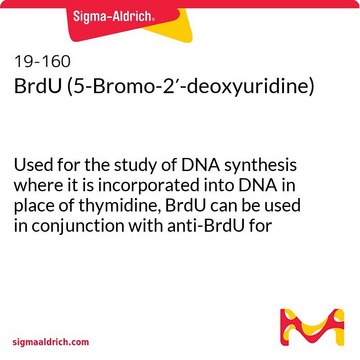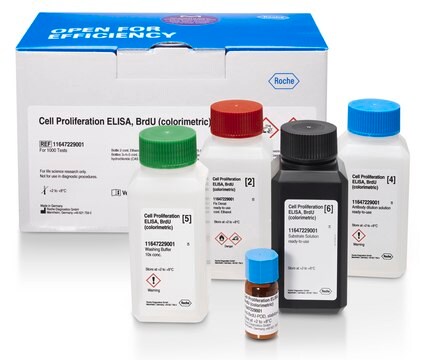QIA58
BrdU Cell Proliferation Assay
This proliferation assay is a non-isotopic immunoassay for quantification of BrdU incorporation into newly synthesized DNA of actively proliferating cells.
Sinônimo(s):
Bromodeoxyuridine Assay
About This Item
Produtos recomendados
Nível de qualidade
uso
sufficient for 1000 tests
sufficient for 200 tests
embalagem
pkg of 1 96-well plate(s)
fabricante/nome comercial
Calbiochem®
condição de armazenamento
OK to freeze
avoid repeated freeze/thaw cycles
entrada
sample type intact cells
sample type intact cells
método de detecção
colorimetric
Condições de expedição
wet ice
temperatura de armazenamento
−20°C
Descrição geral
Componentes
Advertência
Especificações
Princípio
Armazenamento e estabilidade
Prior to use:
1. Remove the Fixative/Denaturing Solution and place at room temperature for at least 4 h prior to use. Precipitates that may occur while cold should go back into solution.
2. Reconstitute the Peroxidase Goat Anti-Mouse IgG with the appropriate volume of 1X PBS.
• For the 200 test kit, reconstitute Peroxidase Goat Anti-Mouse IgG in 125 µl of 1X PBS. Use Conjugate Diluent for any further lot-specific dilution.
• For the 1000 test kit, reconstitute Peroxidase Goat Anti-Mouse IgG in 250 µl of 1X PBS. Use Conjugate Diluent for any further lot-specific dilution.
Allow solution to stand at room temperature for 10 min. (or until solution is clear). Divide into small aliquots; aliquots not to be used that same day should be stored at -20°C in a non-frostfree freezer.
Once the kit components have been thawed for use:
• The BrdU label and 100X Anti-BrdU Antibody should be divided into small aliquots and stored at -20°C in a non-frostfree freezer with the Peroxidase Goat Anti-Mouse IgG; avoid multiple freeze/thaw cycles.
• All the other kit components (Substrate, Antibody Diluent, Conjugate Diluent, 20X Plate Wash Concentrate, Fixative/Denaturing Solution, Stop Solution) should be stored at 4°C.
Outras notas
Muir, D., et al. 1990. Analytical Biochemistry185, 377.
Lanier, T. L., et al. 1989. Carcinogenesis10, 1341.
Magaud, J.-P., et al. 1988. J. Immunol. Methods106, 95.
Collins, S.J. 1987. Blood70, 1233.
Porstmann, T., et al. 1985. J. Immunol. Methods82, 169.
Raza, A., et al. 1985. Cytometry6, 633.
Morstyn, G., et al. 1983. J. Clin. Invest.72, 1844.
Gratzner, H.G. 1982. Science218, 474.
Informações legais
Palavra indicadora
Danger
Frases de perigo
Declarações de precaução
Classificações de perigo
Carc. 2 - Eye Irrit. 2 - Flam. Liq. 2 - Met. Corr. 1 - Muta. 1B - Repr. 2 - Skin Irrit. 2 - Skin Sens. 1
Código de classe de armazenamento
3 - Flammable liquids
Ponto de fulgor (°F)
69.8 °F
Ponto de fulgor (°C)
21 °C
Certificados de análise (COA)
Busque Certificados de análise (COA) digitando o Número do Lote do produto. Os números de lote e remessa podem ser encontrados no rótulo de um produto após a palavra “Lot” ou “Batch”.
Já possui este produto?
Encontre a documentação dos produtos que você adquiriu recentemente na biblioteca de documentos.
Os clientes também visualizaram
Nossa equipe de cientistas tem experiência em todas as áreas de pesquisa, incluindo Life Sciences, ciência de materiais, síntese química, cromatografia, química analítica e muitas outras.
Entre em contato com a assistência técnica












